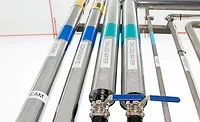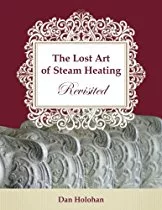Dan Holohan: Dry steam is the goal
Things to consider when replacing a steam boiler.

Image courtesy of anandaBGD / iStock / Getty Images Plus.
I love all the advances taking place in the world of hydronics, but I’m still seeing plenty of steam systems out there in our older cities, so knowing about dry steam will help you if you’re replacing a steam boiler. The dryer the steam is, the better you’re going to look to your customers.
The Hydronics Institute was once obsessed with dry steam. They tested all steam boilers for steam quality. That means that a boiler couldn’t get the I=B=R seal of approval unless it produced 98% quality steam. The I=B=R rating, in other words, was your assurance that the steam boiler you bought would produce good, dry steam.
Steam quality is a measurement of the steam’s dryness. That means the steam should contain no more than 2% liquid water as it leaves the boiler because wet steam can’t hold much latent heat.
Consider this: 94% quality steam at 200 psig (that would be steam containing 6% liquid water) contains the same latent-heat Btu as 98% quality steam at 0 psig. See? When the building won’t heat, raising the steam pressure won’t help you, but piping that replacement boiler properly will.
Wet steam will also increase the pressure drop across the system. That’s because the water creates an additional burden for the steam. It has to shove all that water down the pipe. This can make the returning condensate stack higher than it’s supposed to in the vertical returns of a gravity-return system and that leads to water hammer and squirting main vents.
And to make matters worse, it’s harder to build and hold a head of pressure with wet steam than it is with dry steam. That’s because the wet steam keeps condensing right there in the near-boiler piping. As a result, the Pressuretrol finds it hard to shut off the burner at high limit. Combine that with the diminished latent heat and you’ll see why the fuel bills soar.
Testing boilers for dry steam (you need instruments to do this) was good industry practice, but when the new Department of Energy (DOE) “Heating Capacity” standards arrived in 1978 as a result of the OPEC embargoes, the Hydronics Institute stopped testing steam boilers under 300,000 Btu/h for steam quality. This was mainly because those smaller boilers couldn’t meet the standard. Their sections were too narrow and the supply holes were too small. I=B=R stopped testing because no one can fail a test they’re not taking.
So nowadays, whether or not that little replacement boiler makes dry steam is now entirely up to you and your willingness to follow the manufacturer’s piping instructions. The near-boiler piping became part of the boiler. Piped properly, it does a good job of leaving the liquid water in the boiler and delivering relatively dry steam to the system.
And I can’t blame the boiler manufacturers for the change. They had to meet the higher efficiency standards and to do that, they had to make the boilers smaller, and that meant narrow sections and smaller exit holes. Back in the day, the smallest hole you could find in a residential steam boiler was 3 inches. During the late-1970s, there were residential steam boilers with holes as small as 1-1/4 inches. The velocity of steam leaving those boilers was high enough to suck the water right out of the boiler and send it up into the pipes and radiators.
Steam exit velocity was always a concern during the steam-heating era. Alfred G. King answered this series of questions in his 1923 book, “500 Plain Answers to Direct Questions on Steam, Hot Water, Vapor and Vacuum Heating:”
Q: What should be the area of the riser or risers out of the boiler as compared with the area of the main or mains?
A: The risers out of the boiler should be from 30% to 50% greater in area than the mains which they feed.
Q: What is the reason for employing boiler risers or steam connections so much greater in area than the mains?
A: Because it is advisable that the initial velocity of the steam as it leaves the boiler be as much below the velocity of the steam in the main as possible in order to prevent the lifting of the water into the main
But what is that critical velocity that the steam should never exceed as it leaves the boiler? Alfred King doesn’t say. But Ara Marcus Daniels does. Mr. Daniels was a consultant to the U.S. Government on steam-heating systems during the 1920s. Here’s what he says in his 1928 book, “Steam and Hot Water Heating:”
“Steam heating boilers, unlike power boilers, are not provided with means for assuring dry steam entering the supply lines through the use of ‘dry pipes’ or ‘separators.’ Hence, velocity of flow through the outlets of such boilers should be relatively low – not over 15 feet per second – if the carrying over of water with the steam is to be avoided.”
I took a sampling of six boilers that were popular during that time. These boilers had an average load of 790 square feet EDR (189,600 Btu/h). They were much bigger than today’s boilers. Their sections were wide and could accommodate the steam as it rose through the water, without creating much turbulence at the surface. And the wider sections allowed for large steam exit holes. None of those holes were smaller than 3-inch. The steam exit velocities of those boilers stayed within that critical 15 feet per second mark that Mr. Daniels specified. That’s how they got dry steam.
But today’s steam boilers can’t do this because they have to meet combustion-efficiency standards, which is ironic because if the steam is wet, the system efficiency suffers, even when the combustion efficiency looks great.
But today’s steam boilers can’t do this because they have to meet combustion-efficiency standards, which is ironic because if the steam is wet, the system efficiency suffers, even when the combustion efficiency looks great. And this is why it is so important for you to closely follow the boiler manufacturer’s installation instructions when it comes to near-boiler piping. But keep this in mind as well. Boiler manufacturers compete with each other. If Manufacturer A says you should use one riser to the steam header, Manufacturer B is going to be reluctant to say you should use two risers to that header because that would put them at a competitive disadvantage. But my advice is to use at least two risers to that header because that’s going to slow the steam velocity and give you dryer steam and better system efficiency (think fuel savings and no quiet pipes). If your customer tells you your price is higher than the other guy’s price, show her this column.
And if you want to make that replacement boiler operate even better, increase the size of the risers as they leave the boiler, just as Mr. King advised, and consider piping a drop header instead of a standard header. Drop headers bring the steam to a point that’s higher-than-normal boiler risers would go. From there, the near-boiler piping goes horizontal for a short distance and then drops to feed steam into the top of the steam header. The pipes will take that dry steam from the steam header to the radiators quickly and quietly. Drop headers leave the carryover water back in the boiler and the results are remarkable. If you want to see photos of drop headers, go to HeatingHelp.com. And ask about them on The Wall at that site. Some of the smartest steam people in the country will tell you the same things I’m telling you.
These days, the near-boiler piping is a part of the boiler; and whether or not that next replacement job works as it should is entirely up to you because you’re the pipefitter, and you’re in charge.
And isn’t it nice to be in charge?
Looking for a reprint of this article?
From high-res PDFs to custom plaques, order your copy today!








